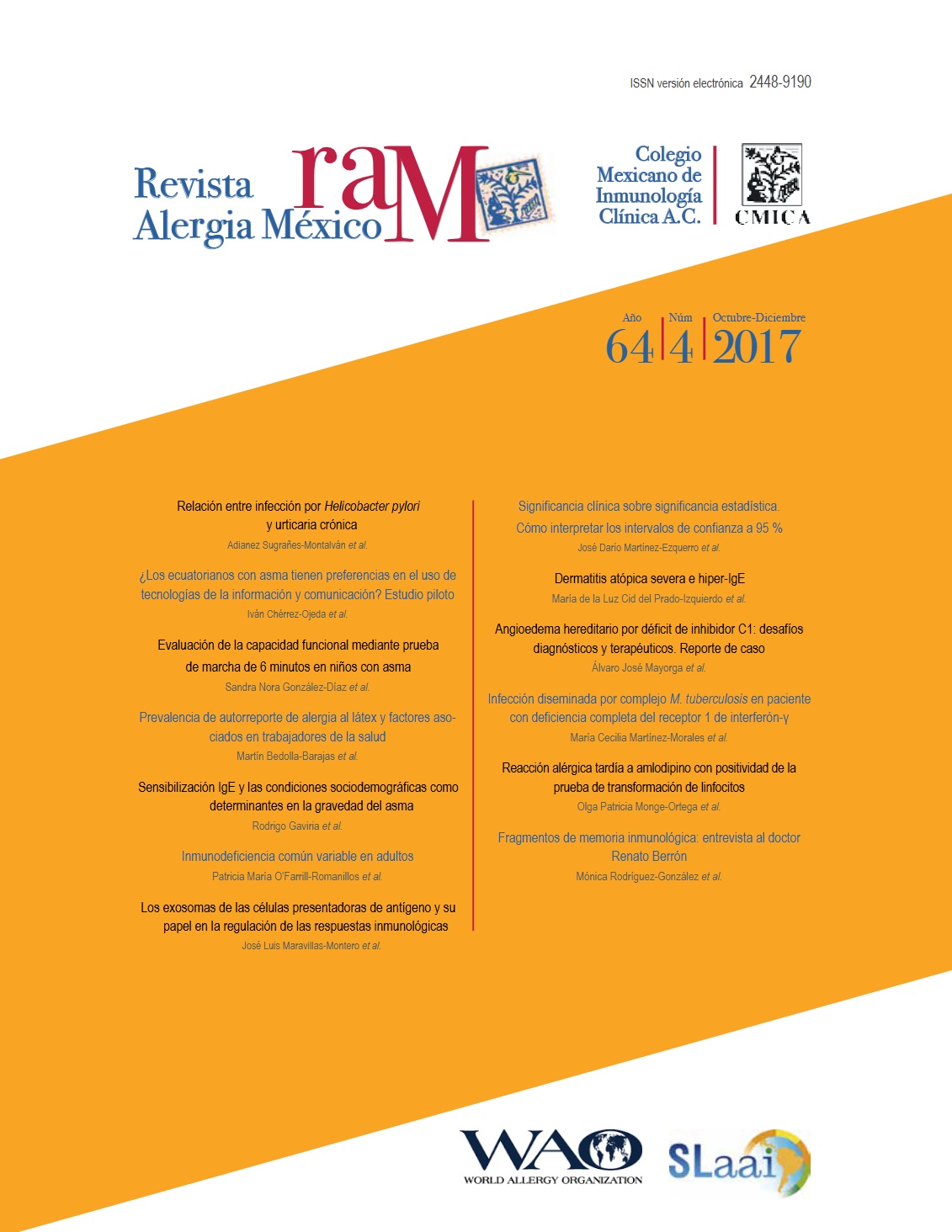Abstract
Background: Inadequate communication between asthmatic patients and their physicians may interfere directly with asthma control. In the last years, the use of information and communication technologies (ICTs) it has increased in Latin-America. This technology seems to be a good tool to improve communication and management of the asthmatic patient.
Objective: We evaluated the frequency and preference patterns of communication and information technologies in Ecuadorian patients with bronchial asthma.
Methods: We conducted a pilot cross-sectional study to identify the frequency and preferences of ICT in patients with asthma. The Spanish version of the Michigan questionnaire was used. Age and educational level were categorized into 3 groups. We used logistic regression between these groups regarding the frequency of use, interest in seeking and receiving information related to their asthma for the age and educational level of the patients.
Results: A total of 222 patients participated in our study. The mean age was 45.6 years (SD 17.4), the most common sex was female with 89.25 %. Almost all patients had a cell phone (87.5 %) and internet access (62.7 %). The three ICTs most likely to be used to search for or receive information about their illness were WhatsApp, Facebook and Email (p <0.05).
Conclusion: Information and communication technologies improve the care of asthmatic patients. In our pilot study email and text messages are the most preferred ICT among patients however WhatsApp and Facebook may be appropriate for certain ages especially young asthmatic. Knowledge of preferences can help the development of ICT in a personalized way and improve the outcomes in patients with asthma.
References
Croisant S. Epidemiology of Asthma: Prevalence and burden of disease. En: Brasier AR, editor. Heterogeneity in asthma. EUA: Springer; 2014.
Masoli M, Fabian D, Holt S, Beasley R, Global Initiative for Asthma Program. The global burden of asthma: executive summary of the GINA Dissemination Committee report. Allergy. 2004;59(5):469-478. DOI: http://dx.doi.org/10.1111/j.1398-9995.2004.00526.x
Gold LS, Montealegre F, Allen‐Ramey FC, Jardim J, Smith N, Sansores R, et al. Level of asthma control and healthcare utilization in Latin America. Allergy. 2013;68(11):1463-1466. DOI: http://dx.doi.org/10.1111/all.12237.
Bender BG, Bender SE. Patient-identified barriers to asthma treatment adherence: responses to interviews, focus groups, and questionnaires. Immunol Allergy Clin North Am. 2005;25(1):107-130. DOI: http://dx.doi.org/10.1016/j.iac.2004.09.005
Nathan RA, Thompson PJ, Price D, Fabbri LM, Salvi S, González-Díaz S, et al. Taking aim at asthma around the world: global results of the asthma insight and management survey in the Asia-Pacific region, Latin America, Europe, Canada, and the United States. J Allergy Clin Immunol Pract. 2015;3(5):734.e5-742.e5. DOI: http://dx.doi.org/10.1016/j.jaip.2015.04.013
Chérrez-Ojeda I, Calderón JC, Mori J, Colombaro D, Braido F, Soria E, et al. Patient-physician relationship in the management of asthma: Multicentric approach in Latin America. J Asthma. 2016;53(7):751-760. DOI: http://dx.doi.org/10.3109/02770903.2016.1145691
Jiménez-Pernett J, García-Gutiérrez JF, Martín-Jiménez JL, Bermúdez-Tamayo C. Tendencias en el uso de Internet como fuente de información sobre salud. UOC Papers. 2007(4):44-50. Disponible en: http://www.redalyc.org/articulo.oa?id=79000411
Perron BE, Taylor HO, Glass JE, Margerum-Leys J. Information and communication technologies in social work. Adv Soc Work. 2010;11(2):67-81.
Buse DC, Lipton RB. Facilitating communication with patients for improved migraine outcomes. Curr Pain Headache Rep. 2008;12(3):230-236.
Lombardi C, Passalacqua G, Canonica GW. The WEB-based Asthma Control: an intriguing connection or a dangerous hazard? Asthma Res Pract. 2015;1(1):15. DOI: http://dx.doi.org/10.1186/s40733-015-0017-z
Baptist AP, Thompson M, Grossman KS, Mohammed L, Sy A, Sanders GM. Social media, text messaging, and email-preferences of asthma patients between 12 and 40 years old. J Asthma. 2011;48(8):824-830. DOI: http://dx.doi.org/10.3109/02770903.2011.608460
Sperber AD. Translation and validation of study instruments for cross-cultural research. Gastroenterology. 2004;126 Suppl 1:S124-S128. DOI: http://dx.doi.org/10.1053/j.gastro.2003.10.016
Naciones Unidas/CEPAL. [Sitio web]. Estado de la banda ancha en América Latina y el Caribe 2016. Serie Documentos de Proyectos núm. 710; 2016. Disponible en: http://repositorio.cepal.org/handle/11362/40528
Pew Research Center. [Sitio web]. Smith A. U. S. smartphone use in 2015. [Actualizado 2015 Abr 1]. http://www.pewinternet.org/2015/04/01/us-smartphone-use-in-2015/
Thakkar J, Kurup R, Laba TL, Santo K, Thiagalingam A, Rodgers A, et al. Mobile telephone text messaging for medication adherence in chronic disease: A meta-analysis. JAMA Intern Med. 2016;176(3):340-349. DOI: http://dx.doi.org/10.1001/jamainternmed.2015.7667
Kaplan WA. Can the ubiquitous power of mobile phones be used to improve health outcomes in developing countries? Global Health. 2006;2(1):9. DOI: http://dx.doi.org/10.1186/1744-8603-2-9
Chretien KC, Kind T. Social media and clinical care: Ethical, professional, and social implications. 2013;127(13):1413-1421. DOI: http://dx.doi.org/10.1161/CIRCULATIONAHA.112.128017
Chou W-YS, Hunt YM, Beckjord EB, Moser RP, Hesse BW. Social media use in the United States: Implications for health communication. J Med Internet Res. 2009;11(4):e48. DOI: http://dx.doi.org/10.2196/jmir.1249
Hanson CL, West J, Thackeray R, Barnes MD, Downey J. Understanding and predicting social media use among community health center patients: A cross-sectional survey. J Med Internet Res. 2014;16(11):e270. DOI: http://dx.doi.org/10.2196/jmir.3373
GlobalWebIndex. [Sitio web]. Young K. WhatsApp usage highest in LatAm. GlobalWebIndex. The trends to watch in 2017. Reino Unido: GlobalWebIndex; 2016. Disponible en: https://blog.globalwebindex.net/chart-of-the-day/whatsapp-usage-highest-in-latam/

This work is licensed under a Creative Commons Attribution-NonCommercial 4.0 International License.
Copyright (c) 2017 Revista Alergia México

